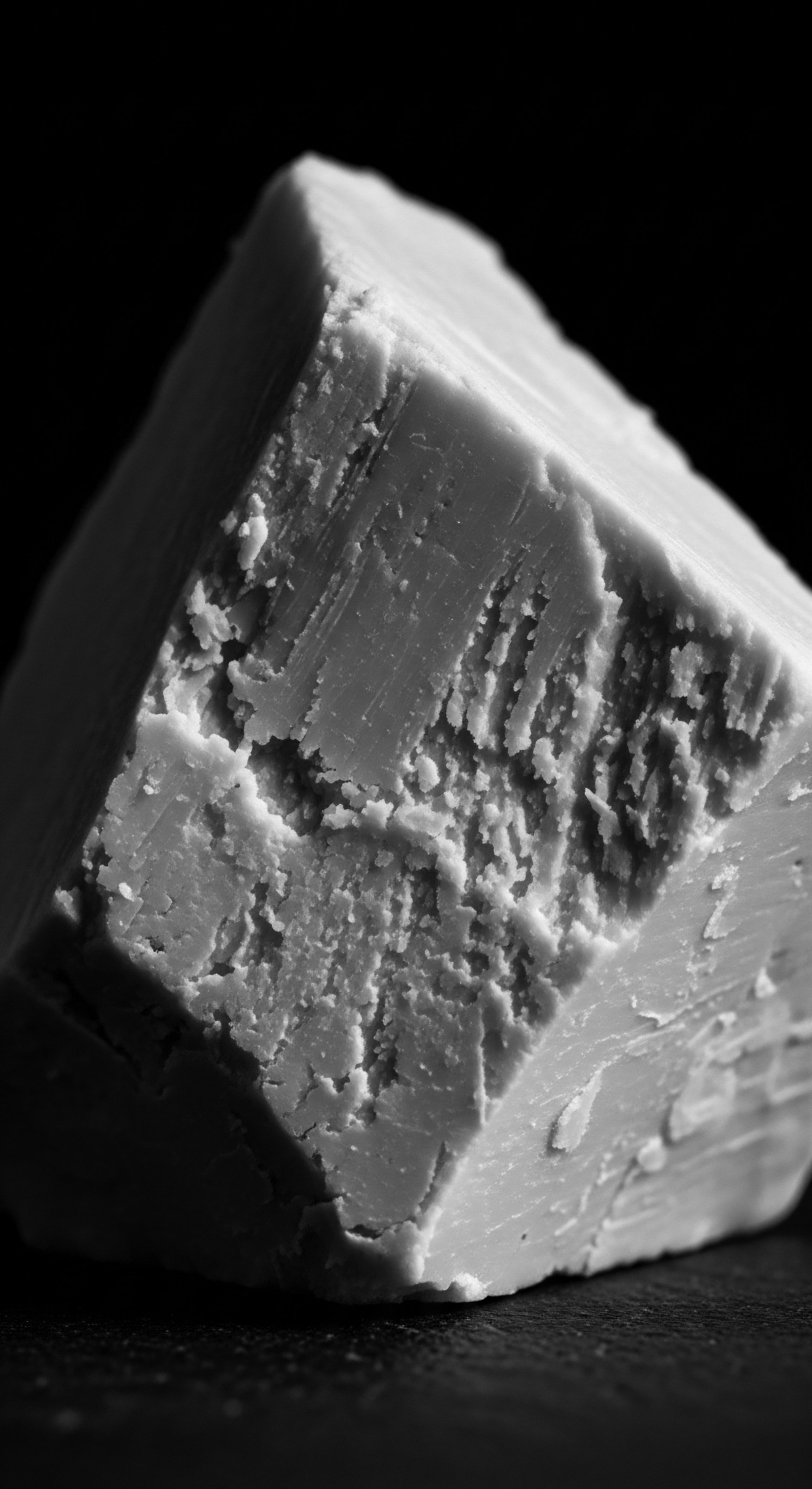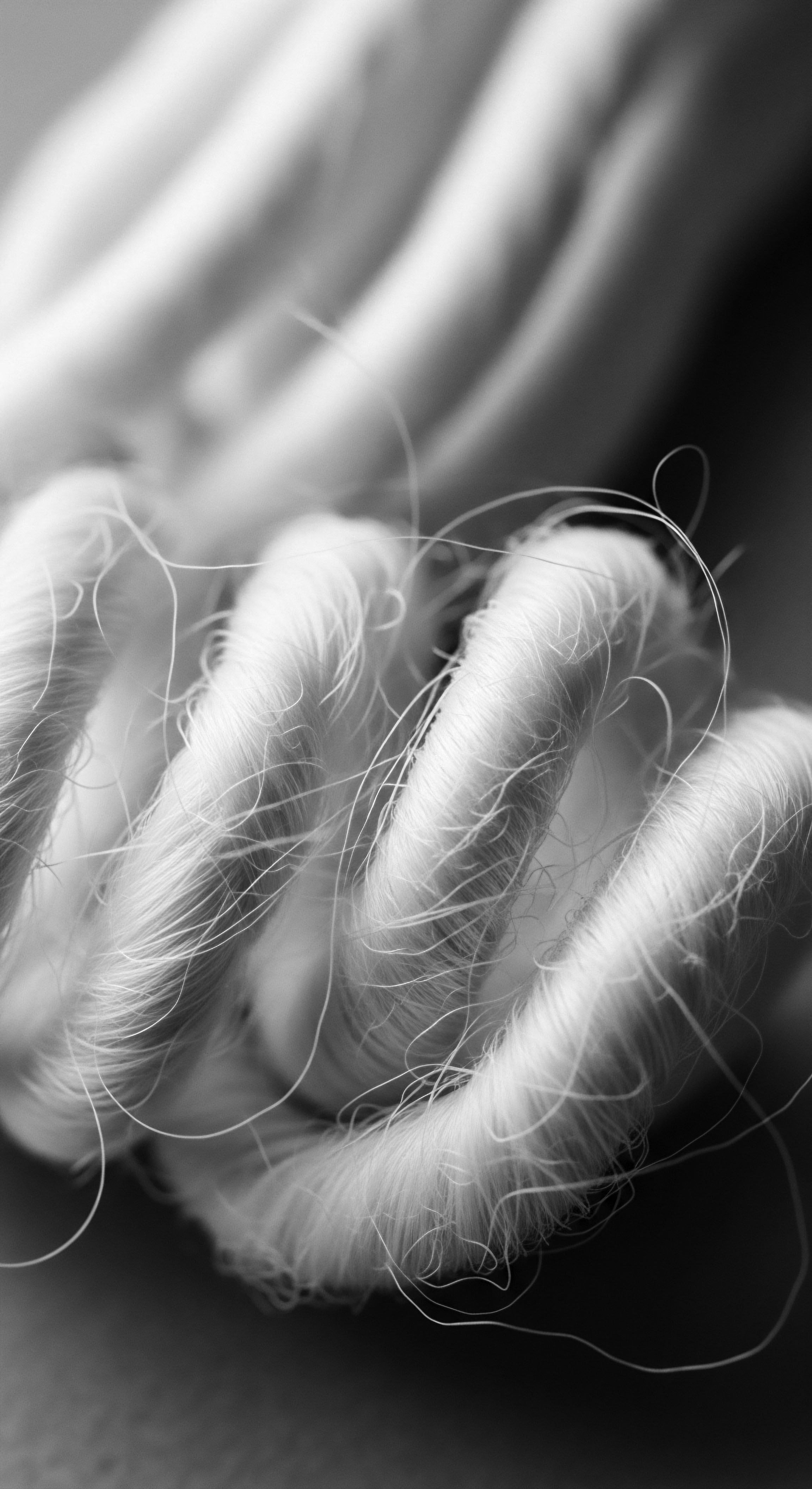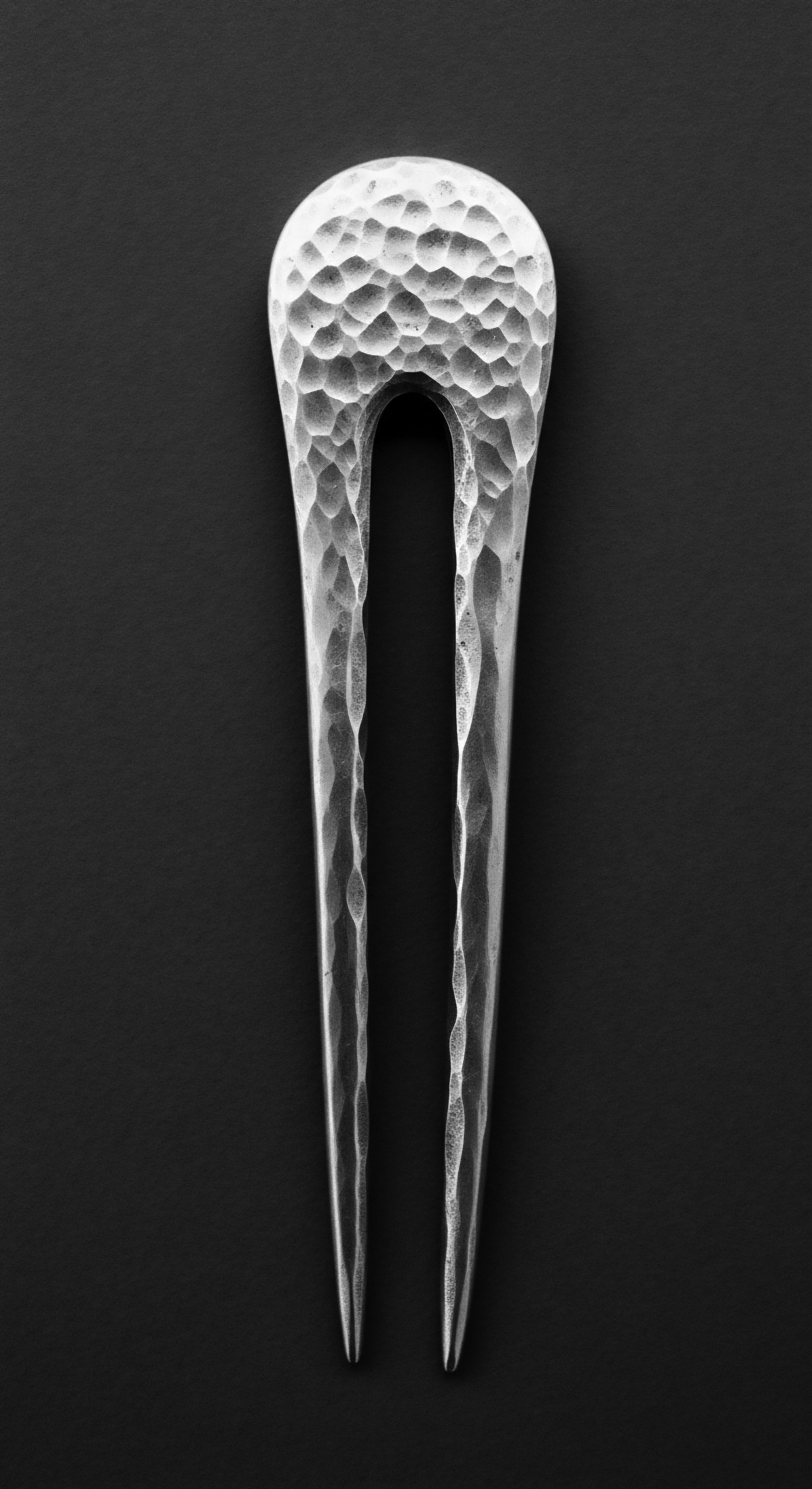
Fundamentals
Hormonal Hair Loss, at its elemental meaning, refers to the shedding or thinning of hair caused by fluctuations in the body’s endocrine system. It is a profound shift in the natural cycle of hair growth, where the delicate balance of hormones, those silent messengers within us, can disrupt the very life of a strand. This is not simply about losing hair; it is about the body speaking in whispers, signaling changes in its internal rhythm.
When we speak of hormonal hair loss, we refer to the disruption of the hair growth cycle—a process that typically sees hair follicles move through phases of growth (anagen), transition (catagen), and rest (telogen). Hormonal shifts can prematurely usher follicles into the resting phase, leading to increased shedding and diminished regrowth.
For those with Textured Hair Heritage, this understanding holds a particular resonance. Hair, for many in the Black and mixed-race diaspora, is far more than mere adornment; it is a living chronicle, a connection to ancestry, and a declaration of identity. Therefore, any alteration to its natural state, particularly one rooted in the body’s own changing landscape, carries weight. This phenomenon encompasses various manifestations, from generalized thinning to more localized patterns, all stemming from the profound influence of hormones on the delicate ecosystem of the scalp.
Hormonal Hair Loss signifies a disruption in the hair’s natural growth cycle, often reflecting deeper physiological shifts within the body.
Consider the stages of life that bring about significant hormonal shifts ❉ the blossoming of adolescence, the journey of pregnancy and postpartum, the graceful transition of menopause, and even the ebb and flow of daily stress. Each of these periods can introduce a symphony of hormonal changes that directly impact hair health. For textured hair, which often possesses unique structural characteristics—such as an elliptical follicle shape and a propensity for dryness—these hormonal influences can manifest distinctively, sometimes exacerbating existing fragilities. The careful stewardship of hair, passed down through generations, becomes even more significant when confronting these internal shifts.
The definition of hormonal hair loss, then, extends beyond a mere biological explanation; it becomes an interpretation of how the body’s internal narrative influences our external presentation, especially for those whose hair carries such profound cultural and historical weight. This understanding guides us to approach care not just with scientific rigor, but with the deep reverence for heritage that textured hair demands.

Intermediate
Moving beyond the foundational understanding, the intermediate meaning of Hormonal Hair Loss deepens our appreciation for its complex interplay with the body’s endocrine symphony. This isn’t a singular event but a continuous dialogue between our internal landscape and the living strands that crown us. Hormones, these powerful chemical messengers, orchestrate countless bodily functions, and their influence on the hair follicle is substantial. When their balance falters, whether through excess or deficiency, the hair growth cycle can falter in turn.
For individuals with Textured Hair, particularly those within Black and mixed-race communities, the implications of hormonal shifts are layered with historical and cultural context. Our hair, a living testament to resilience and ancestral memory, responds to these internal dialogues in ways that can be both unique and challenging. For example, conditions such as polycystic ovary syndrome (PCOS), characterized by elevated androgens, can lead to hair thinning, particularly at the crown, a pattern known as female pattern hair loss. Thyroid disorders, too, whether hyperthyroidism or hypothyroidism, can affect the hair growth cycle, causing either excessive shedding or coarseness.
Consider the profound transition of Menopause, a universal journey with culturally varied expressions. As estrogen and progesterone levels decline, hair can become thinner and more fragile. For Afro-textured hair, already prone to dryness and breakage due to its unique coiled structure and elliptical follicle shape, this reduction in natural oil production can intensify existing vulnerabilities.
Traditional African and Afro-Caribbean hair care practices, often emphasizing natural ingredients like Shea Butter and Coconut Oil, have long provided a holistic approach to mitigating such dryness and promoting overall hair health during these transitions. These ancestral practices, passed down through generations, offer a profound connection to wellbeing that extends beyond mere cosmetic application.
The significance of hair in Black culture, often referred to as a “crown,” means that hair loss, regardless of its cause, carries a significant emotional and psychological impact. It is not merely a cosmetic concern but a deeply personal experience that can affect one’s sense of femininity and identity. Understanding hormonal hair loss within this context necessitates an approach that respects both scientific understanding and the profound cultural meanings woven into every strand.
| Traditional Ingredient/Practice Shea Butter (Vitellaria paradoxa) |
| Ancestral Use/Cultural Significance Used across West Africa for centuries to moisturize hair and scalp, protect from elements, and promote softness. Revered for its nourishing properties. |
| Potential Modern Scientific Link (Hormonal Hair Loss) Rich in fatty acids and vitamins (A, E), which can nourish the scalp and hair, improving elasticity and reducing breakage, thus supporting hair health amidst hormonal dryness. |
| Traditional Ingredient/Practice Coconut Oil (Cocos nucifera) |
| Ancestral Use/Cultural Significance A staple in many Afro-Caribbean and African traditions for deep conditioning, adding shine, and sealing in moisture. Valued for its penetrating abilities. |
| Potential Modern Scientific Link (Hormonal Hair Loss) Its molecular structure allows it to penetrate the hair shaft, reducing protein loss. This protection can be vital when hair is weakened by hormonal changes, making it less prone to damage. |
| Traditional Ingredient/Practice Herbal Scalp Massages |
| Ancestral Use/Cultural Significance Ancient practice to stimulate circulation, distribute natural oils, and apply medicinal herbs. A ritual of care and connection. |
| Potential Modern Scientific Link (Hormonal Hair Loss) Improved blood flow to hair follicles can enhance nutrient delivery and oxygenation, potentially supporting healthier hair growth cycles influenced by hormonal balance. |
| Traditional Ingredient/Practice These traditional practices, deeply rooted in heritage, often align with modern understanding of hair health, offering a holistic path to managing hormonal influences. |
The role of stress, too, cannot be overlooked in this intermediate explanation. High levels of cortisol, a stress hormone, can disrupt the hair growth cycle, leading to increased shedding. For Black women, the historical and ongoing experiences of systemic racism and discrimination add layers of psychological and physiological stress that can indirectly impact hair health. The fight for natural hair acceptance, for instance, has been a significant cultural and political statement, highlighting the pressures and biases faced by Black women regarding their hair.
The interplay of genetics, cultural practices, and life transitions shapes the unique experience of hormonal hair loss within textured hair communities.
This intermediate understanding invites a more nuanced perspective, acknowledging that hormonal hair loss in textured hair is not merely a biological anomaly but a phenomenon interwoven with lived experiences, cultural narratives, and ancestral wisdom. It underscores the importance of a comprehensive approach that considers the whole person, their heritage, and their unique hair journey.

Academic
The academic delineation of Hormonal Hair Loss transcends simplistic explanations, offering a sophisticated examination of its multifaceted causality and its profound implications, particularly within the context of Textured Hair Biology and the ancestral legacies of Black and mixed-race communities. This is not merely a biological event but a complex physiological phenomenon intricately bound to genetics, environmental factors, and the profound psychosocial landscape of identity and heritage.

Endocrine Orchestration and Follicular Response
At its core, hormonal hair loss represents a dysregulation of the intricate endocrine signaling pathways that govern the hair follicle’s cyclical activity. The hair follicle, a dynamic mini-organ, is highly sensitive to fluctuations in various hormones, including androgens (like testosterone and dihydrotestosterone, DHT), estrogens, thyroid hormones, and even stress-related corticosteroids. Androgens, in particular, play a significant role in androgenetic alopecia (AGA), often referred to as female pattern hair loss (FPHL) in women.
While typically associated with male pattern baldness, women also produce androgens, and an increased sensitivity of hair follicles to these hormones, or an elevation in their levels, can lead to follicular miniaturization—a process where hair follicles shrink, producing progressively finer, shorter hairs until they cease production altogether. The follicular morphology of textured hair, characterized by its elliptical cross-section and curved growth path, may influence how these hormonal signals are received and expressed, potentially contributing to specific patterns of thinning or fragility.
Estrogens, conversely, are largely considered protective for hair, prolonging the anagen (growth) phase of the hair cycle. A decline in estrogen, such as during Menopause, can lead to a shorter anagen phase and an increased proportion of follicles entering the telogen (resting) phase, resulting in diffuse shedding and reduced hair density. For women of African descent, the average age of menopause onset can vary, and cultural perceptions of this life stage can significantly influence how these physiological changes, including hair thinning, are perceived and managed.
Hormonal influences on hair growth are shaped not only by biological factors but also by the unique structural properties of textured hair and the socio-cultural narratives surrounding it.
Thyroid hormones (T3 and T4) are also critical regulators of hair follicle function. Both hypothyroidism (underactive thyroid) and hyperthyroidism (overactive thyroid) can disrupt the hair cycle, leading to hair loss or changes in hair texture. The prevalence of thyroid disorders in African women, often linked to nutritional deficiencies or autoimmune conditions, adds another layer of complexity to understanding hormonal hair loss within these populations.

Interconnected Incidences and Cultural Dimensions
The meaning of Hormonal Hair Loss within textured hair heritage is deeply interwoven with a history of both physiological predisposition and societal pressures. A particularly poignant example lies in the experience of Central Centrifugal Cicatricial Alopecia (CCCA), a form of scarring hair loss predominantly affecting women of African descent. While not exclusively hormonal, CCCA is often exacerbated by practices, some historically driven by societal expectations, that place tension on the hair follicle, such as tight braiding, weaves, and chemical relaxers. This mechanical stress, combined with an underlying genetic susceptibility and potential inflammatory responses, can lead to permanent hair loss at the crown, a deeply symbolic area of the head.
This particular incidence powerfully illuminates the connection between biological vulnerability, cultural practices, and historical context. The pressure to conform to Eurocentric beauty standards, which often favored straight hair, led many Black women to adopt styling methods that, over time, could compromise hair follicle integrity. This cultural adaptation, while a means of survival and social navigation, inadvertently contributed to hair health challenges, including those where hormonal changes might further sensitize the follicles to external stressors. The emotional impact of hair loss in the African diaspora is profound; hair is often considered a “crown,” a symbol of femininity, identity, and beauty, making its loss a deeply personal and often distressing experience.
- Follicular Miniaturization in Androgenetic Alopecia (AGA) ❉ This process involves the progressive shrinking of hair follicles under the influence of androgens, leading to thinner, shorter hairs. While common globally, its manifestation in textured hair can be influenced by inherent structural differences, potentially affecting how diffuse thinning presents on the scalp.
- Telogen Effluvium (TE) from Hormonal Stressors ❉ Conditions like postpartum hormonal shifts or chronic stress (elevated cortisol) can trigger a large number of hairs to prematurely enter the telogen phase, resulting in widespread shedding. This can be particularly noticeable in textured hair, where density is often a valued attribute.
- Perimenopausal and Menopausal Hair Thinning ❉ The decline in estrogen during these life stages contributes to reduced hair density and growth rates. For Afro-textured hair, which can already be prone to dryness and breakage, this hormonal shift may exacerbate these concerns, necessitating targeted care strategies.
- Thyroid-Related Alopecia ❉ Both hypo- and hyperthyroidism can cause diffuse hair loss or changes in hair texture. The systemic nature of these hormonal imbalances means that hair health is often an early indicator of broader endocrine disruption.
The interplay of genetic predispositions, hormonal sensitivities, and the historical use of certain styling practices presents a complex landscape. For instance, while traction alopecia is directly caused by physical stress, the underlying hormonal environment of an individual might influence the follicle’s susceptibility to damage or its capacity for recovery. Research highlights that women of African descent are disproportionately affected by certain types of hair loss, and understanding the history of hair care practices is imperative for dermatologists to provide culturally sensitive care.
The academic understanding of Hormonal Hair Loss, particularly within the textured hair community, necessitates a critical lens that acknowledges the socio-historical determinants of health. It moves beyond a purely biomedical model to encompass the lived experiences, cultural resilience, and ancestral knowledge that inform approaches to hair care and wellness. This requires a synthesis of endocrinology, dermatology, anthropology, and cultural studies to truly grasp the profound impact of hormonal changes on the hair of those whose strands carry generations of stories.

Reflection on the Heritage of Hormonal Hair Loss
The journey through the intricate landscape of Hormonal Hair Loss, viewed through the profound lens of Roothea’s ‘Soul of a Strand’ ethos, compels us to acknowledge that hair is more than a biological appendage; it is a living archive, a repository of heritage, and a vibrant expression of identity. For those with textured hair, particularly within the Black and mixed-race diaspora, the experience of hormonal shifts impacting hair carries echoes from ancestral practices and whispers of resilience. It is a reminder that our bodies are not isolated entities but vessels carrying forward generational stories, and our hair, in its myriad forms, serves as a powerful testament to this unbroken lineage.
From the ancient communal rituals of hair dressing, where care was woven with connection and spiritual significance, to the contemporary understanding of hormonal influences, there is a continuous thread of human ingenuity and adaptation. The wisdom of our foremothers, who intuitively understood the power of natural emollients like Shea Butter and Coconut Oil to nurture and protect, resonates with modern scientific insights into hair health during hormonal transitions. These practices were not simply about aesthetics; they were acts of profound self-care, communal bonding, and a quiet defiance against forces that sought to diminish the spirit.
The challenges of hormonal hair loss, such as those experienced during menopause or exacerbated by conditions like CCCA, invite us to look deeper. They prompt us to honor the struggles and adaptations of past generations, recognizing how societal pressures and historical injustices have shaped hair practices and, consequently, hair health within our communities. Yet, in this reflection, we also find immense strength.
The enduring spirit of Black women, who have consistently reclaimed and redefined beauty standards despite adversity, shines through. Their ability to find beauty and self-acceptance, even in the face of hair changes, is a powerful legacy.
The path forward, illuminated by this heritage-centric understanding, is one of holistic care. It calls for a blend of scientific knowledge and ancestral wisdom, recognizing that true wellness for textured hair encompasses not only physiological balance but also emotional wellbeing and a deep connection to one’s roots. Our hair, whether full and flowing or experiencing a period of thinning, remains a sacred part of who we are—a continuous narrative of resilience, beauty, and an unbound helix connecting us to all who came before.

References
- Byrd, A. D. & Tharps, L. D. (2014). Hair Story ❉ Untangling the Roots of Black Hair in America. St. Martin’s Publishing.
- Clarke-Jeffers, P. Keyte, R. & Connabeer, K. (2024). “Hair is your crown and glory” – Black women’s experiences of living with alopecia and the role of social support. Health Psychology Report, 12(1).
- Grymowicz, M. Rudnicka, E. Podfigurna, A. Napierala, P. Smolarczyk, R. Smolarczyk, K. & Meczekalski, B. (2020). Hormonal Effects on Hair Follicles. International Journal of Molecular Sciences, 21(15), 5342.
- Khumalo, N. P. Doe, P. T. Dawber, R. P. & Ferguson, D. J. (2000). What is normal black African hair? A light and scanning electron-microscopic study. Journal of the American Academy of Dermatology, 43(5 Pt 1), 814–820.
- Loussouarn, G. Lozano, I. Panhard, S. Collaudin, C. El Rawadi, C. & Genain, G. (2016). Diversity in human hair growth, diameter, colour and shape. An in vivo study on young adults from 24 different ethnic groups observed in the five continents. European Journal of Dermatology, 26(2), 144–154.
- McMichael, A. J. (2003). Hair care practices in African American women. Cutis, 72(4), 280–282, 285–289.
- Panhard, S. et al. (2016). Diversity in human hair growth, diameter, colour and shape. An in vivo study on young adults from 24 different ethnic groups observed in the five continents. European Journal of Dermatology, 26(2), 144–154.
- Robbins, C. R. (2012). Chemical and Physical Behavior of Human Hair. Springer Science & Business Media.
- Rodney King ❉ Provocations and protests, progression and ‘post-racialism’. Routledge. (2003).
- Tanus, A. Oliveira, C. C. Villarreal, D. J. Sanchez, F. A. & Dias, M. F. (2021). Black women’s hair ❉ the main scalp dermatoses and aesthetic practices in women of African ethnicity. An Bras Dermatol, 96(3), 323–333.
- Thompson, S. (2009). Madam C.J. Walker ❉ The Making of an American Icon. Scribner.
